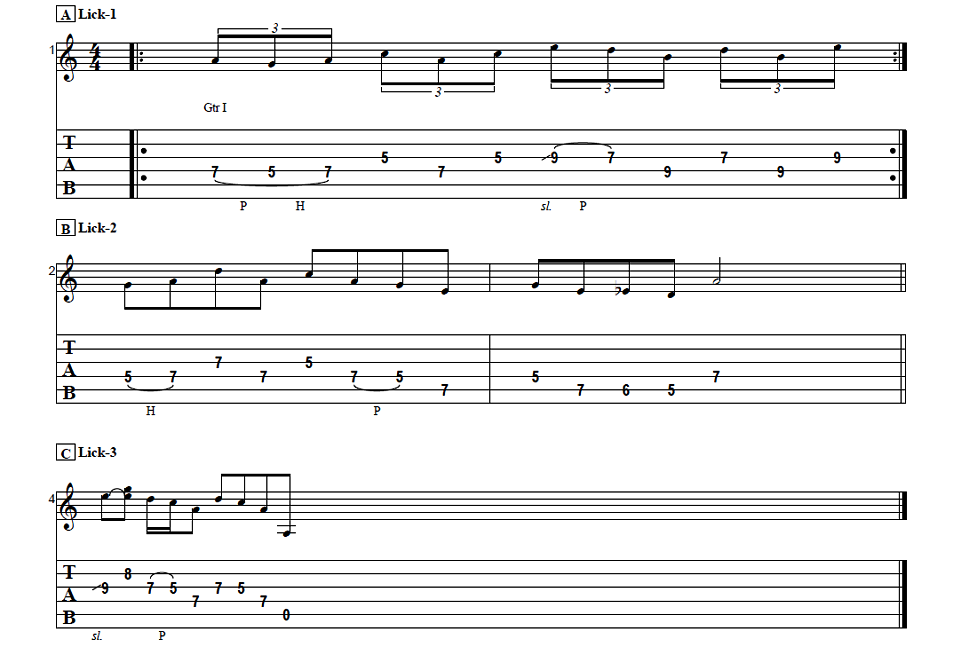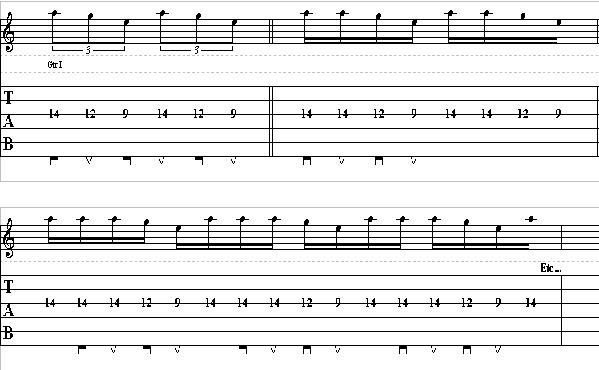Ok, for you experienced cats, this should be familiar territory, but hang with me, I’ve got a cool challenge for you.
And for the newbees, hopefully I can shed light on this very important topic: PHRASING.
What is PHRASING? Phrasing is the little subtleties , nuances, and refined details of HOW you play
a phrase or lick.
Just like in a langauage such as in English — the words of a sentence are one thing, but
the phrasing is something else – how are you saying it? Which word are you emphasizing? Are
you saying it fast? Slow? Loud? Quiet? With what kind of emotion? Accent? Etc.
Technically, some musicians would say that phrasing includes how
you group notes together and what rhythms you’re using but
I say the basic rhythm is simply “the rhythm” to make things simple.
To me, phrasing refers to the tiny details. First of all, how are you
attacking the note? Are you playing the notes soft or loud?
Picking them with a pick? Is it an upstroke or downstroke for any given
note? Is it alternate picking or economy picking?
Tapping? Using your nails? Or maybe the fleshy part of your fingers?
Second, what about slides, bends, vibrato, and legato?
Those 4 things have an enormous impact on how a lick sounds.
Then there are other advanced techniques like whammy bar, artificial harmonics, raking, or volume swells.
What about timing? Guitar is a very lyrical instrument so even if you have
a basic rhythm of notes, there may be tiny variations in exactly how long you’re holding
the notes (or how long you’re resting) that are practically impossible to notate, but are
important to getting the exact feel you want.
And finally, what is the emotion or feel behind the lick you want.
So how do you develop killer phrasing?
First, listen to players with killer phrasing.
Some of my favorites are B.B. King, Jimmy Hendrix, Stevie Ray Vaughan,
Eric Clapton, Mark Knopfler, and Steve Vai.
On the surface, they all just have an awesome style
that expresses their personality. But if you look closer
at individual licks, you’ll start to notice little things
like bends, slides, legato (hammerons and pulloffs), and vibrato.
Then, you should learn these basic lead guitar techniques yourself,
and as you gain more experience, you’ll naturally start using them
more and more.
At a more advanced stage, you can start recording yourself and listening
to your own playing to see where your phrasing could be improved.
Generally, you will have a sense of “what you were going for” and you
can “fine tune” your phrasing to get closer to the sound in your head.
To give you a specific exercise today, I recorded a guitar lick that
has 14 notes in it.
If you want a challenge, just push play now and then try to figure
out the lick on your own. Try to play it with the exact phrasing I’m using.
Could you figure it out and play it exactly like me?
If not, don’t worry because I don’t expect many players to figure it
out without some explaination and the tabs.
Ok, so the tab are below but let me describe the phrasing subtleties here.
I’m playing in the key of A pentatonic, starting at the high A note
which is on the 10th fret of the B string.
I’m basically using a 3-note-per string pentatonic pattern and going
up the scale – however, I skip the second note just to give some flavor
to the lick.
This requires a bit of a stretch – hit the first note with your index
finger and the next note with your pinky. If you’re a beginner,
don’t worry if you can’t get this right away either. Just take it
real slow and don’t be afraid to lift your hand off and reposition it
if you can’t get that wide stretch.
On the high E string, hit the 12th fret with your first finger
and the 15th fret with your ring finger.
Now here’s where the phrasing starts coming in – with your ring
finger already on the 15th fret, pick the 15th while sliding up quickly to the 17th and when
you get up to the 17th fret, hold it and add vibrato
(shake the note). The second time you’re picking the 15th fret, its really only a “grace note”
which is a starting point to slide up to the 17th fret.
You should be picking every note so far (except at the 17th fret, which you slide into),
but whether you’re using upstrokes
or downstrokes isn’t crucial here.
Did you get all that? Good! That’s the first part of the phrase.
Now we’ll come back down the scale and resolve it.
Next part: Pick the 15th fret on the high E string with your ring finger,
then the 12th fret with your first finger.
Now pick the 15th fret on the B string with your ring finger, and THEN…
Here’s the tricky part — pick the 15th fret again, and slide up to the 17th
and back down to the 15th. (these last two notes should not be picked)
As you come back down to the 15th fret, give a tiny 1/4 note bend – just
a “tiny tug” to give it some blues feel. Unlike in the first part of the lick, there is no “grace note” here. The
note you’re playing while sliding are actual eighth notes.
Then pick the 13th fret on the B string and optionally, give it the tiniest of bends also.
Finally, the last note is the 14th fret on the G string which you will pick
twice. The first time is just a short note, the second is a longer note which
you’ll give a healthy dose of vibrato.
See how many little details can go into a short lick to give it the right feel?
Here’s a tab of it – don’t read too much into the rhythm of it because like I said,
the exact feel of a lick can contain a certain timing that is difficult to notate.

Instead, use your ears. LISTEN… And try to recreate the sound on your guitar.
So what’s next? I’ll tell you what’s next — grab yourself a DVD guitar course. They are fun,
come with tabs, and are a great way to take your playing to an entirely new realm.
I have 3 guitar learning recommendations for you today:
1. If you want to learn more about lead guitar, playing with feel, and phrasing,
Click Here to Visit Guitar Control.
2. If this stuff seems too basic for you and you’re hungry for really advanced stuff,
Click Here to Visit Fusion Guitar secrets.
3. If you love blues and want to learn some EASY-TO-USE blues guitar
‘from one of the best blues guitar teachers around,
Click Here to Visit Rocking the Blues.


